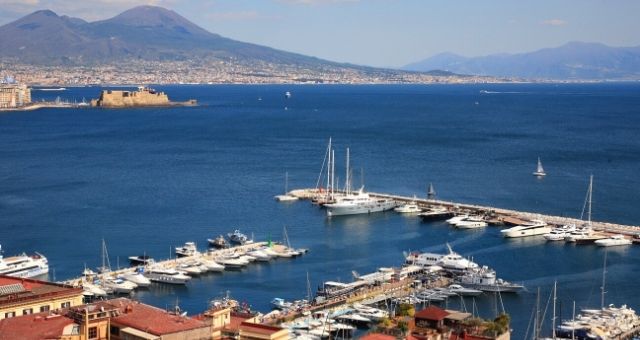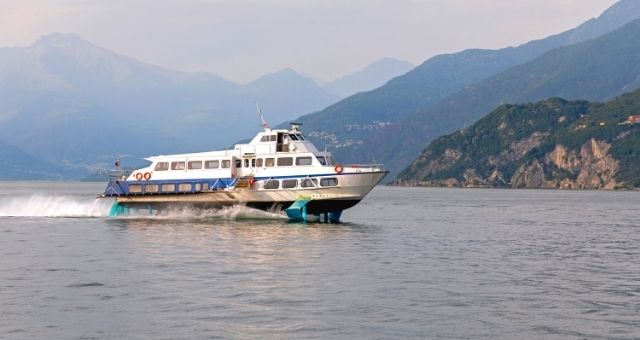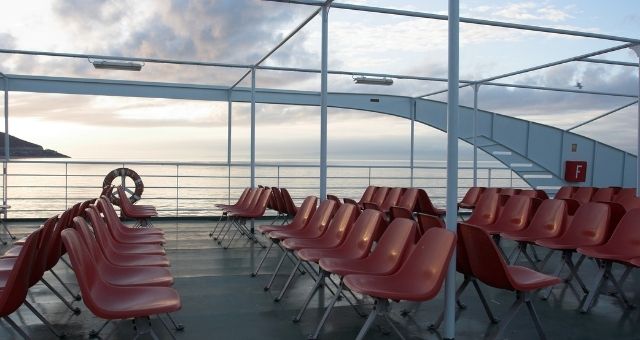Ferry or hydrofoil: what's the difference?
Solving one of the top sea mysteriesWhen booking a sea trip in Italy, you may come across 2 options: ferries and hydrofoils. Although most of us know what to expect when hearing the word “ferry”, hydrofoils sound a bit like a mythical sea creature, even if many ferry companies have them in their fleet.
In this article, you will learn about the main differences between a ferry and a hydrofoil, so that you choose what suits you best for your next trip! Moreover, you can check some popular Italian routes that are served by both ferries and hydrofoils.

Ferries and hydrofoils docked at the port of Naples
Hydrofoil vs ferry: understanding the differences
The main differences between ferries and hydrofoils are related to their structure, services and on-board facilities. Ferries (both conventional and high-speed) are usually larger than hydrofoils and operate on longer routes. On the other hand, hydrofoils are popular choices for quick crossings or as alternatives for tourist boats.
See more details about ferries and hydrofoils in Italy below.
What’s a hydrofoil?
Hydrofoils are generally smaller vessels with no cabins or car decks for the transportation of motor vehicles. They have a distinctive structure, with a wing-like look in the lower part of the load-bearing surfaces, similar to the one of airplanes.
At low speeds, a hydrofoil operates like a conventional ferry. But as the speed increases, something changes: the vessel emerges and continues its navigation supported only by its wings, as if it “flies” over the sea surface!
Compared to the hull of a ferry that sails submerged, this system gives hydrofoils greater speed and reduces travel time.
Some companies that operate with hydrofoils, allow passengers to travel with their pets, on the condition that their furry friends wear a leash and a muzzle. Passengers with small pets are usually required to keep them inside their cages or carriers.
As for luggage limits, on hydrofoils you can normally bring only 1 piece of baggage of a specific size. We recommend that you always check with the operator about vessel specifics before booking your tickets.
Note: as hydrofoils are usually faster, hydrofoil tickets may cost more than ferry tickets. However, this cost difference also depends on the route and the additional services available on board.
Main characteristics of a ferry
Regarding capacity and size, ferries can be larger or smaller. Normally, large ferries operate on longer routes, while smaller vessels serve shorter crossings.
The larger the ferry, the more vehicles and passengers it can accommodate. However, bear in mind that not all ferries have car decks, although most do. Similarly, larger ferries tend to come with cabins of different sizes and amenities.
Moreover, depending on their speed, ferries can be conventional or high-speed ones.
On most ferries, you are allowed to travel with your pet. Your little friend is allowed to walk with you on the deck, provided that it wears a leash and a muzzle. Common areas are normally off limits, but some companies offer special pet-friendly cabins.
Ferryhopper suggests that you check the vessels' facilities and contact the ferry companies if you have any questions. This also applies to baggage policy, which varies from one company to another.

A hydrofoil picking up speed near the Italian coast
Popular routes in Italy served by hydrofoils and ferries
If you are dreaming of a trip in southern Italy, and want to discover the beauties of Campania and the Gulf of Naples, bear in mind that most crossings are operated by both ferries and hydrofoils.
Depending on your needs, you can choose either a ferry or a hydrofoil when traveling on these 6 routes:
1. Ferries and hydrofoils from Naples to Ischia
The Naples - Ischia ferry route is active all year round with over 30 connections per day. Ferries operating on this route take over 1 hour to reach the island, while make the trip in around 50 minutes.
Ferries depart from the Calata Porta di Massa pier, while hydrofoils to Ischia from Naples depart from Molo Beverello. The two piers are connected by a free shuttle that runs until midnight.
Tip: also take a look at the return ferry route from Ischia to Naples, see ferry and hydrofoil schedules, and pick the best option for you.
2. Ferries and hydrofoils from Naples to Procida
The ferry route from Naples to Procida is served with 20 daily connections available all year round. The ferry takes up to 1 hour 30 minutes to get to Procida, while hydrofoils reach the island in about 30 minutes.
Both ferries and hydrofoils from Naples to Procida depart from Molo Beverello and Calata Porta di Massa. The piers are about 2 km from the Naples central train station and you can get there on foot, by taxi, bus or metro.
3. Ferries and hydrofoils from Sorrento to Capri
The Sorrento - Capri ferry route is operated with more than 20 daily crossings available all year round. The route is operated by hydrofoils and high-speed ferries that usually reach the island in 15-30 minutes.
Both ferries and hydrofoils to Capri depart from the port of Marina Piccola, which is located very close to the historic center of Sorrento.
4. Ferries and hydrofoils from Ischia to Capri
The ferry route from Ischia to Capri is available twice a day. It's operated by hydrofoils and high-speed ferries that reach the island in approximately 40-50 minutes.
Ferries and hydrofoils to Capri depart from all 3 main ports of Ischia (Ischia Porto, Casamicciola and Forio), as well as from the small tourist port of Lacco Ameno.
5. Ferries and hydrofoils from Milazzo to Lipari
The Milazzo - Lipari ferry connection (the largest of the Aeolian Islands) is operated by both ferries and hydrofoils. Travel time ranges between 50 minutes and 2 hours 15 minutes.
The Liberty Lines hydrofoils to Lipari from Milazzo depart from the pier in Via Ammiraglio Luigi Rizzo, while the Siremar ferries depart from the pier near Via dei Mille.
6. Ferries and hydrofoils from Trapani to Favignana
There are more than 20 crossings per day from Trapani to Favignana (the largest of the Egadi Islands). Their duration ranges between 30 minutes and 1 hour 20 minutes, depending on the type of vessel you choose.
The hydrofoils to Favignana from Trapani leave from the pier in Via Ammiraglio Staiti, while the ferries depart from the pier in Viale Regina Elena.
See all Italy ferry schedules for 2024

Enjoying a beautiful Italian sunset on the ferry deck
Book ferry / hydrofoil tickets for Italy online
On Ferryhopper, you can book cheap ferry and hydrofoil tickets for Italy and beyond. Check the vessel types and amenities, compare prices and timetables, and plan your trip online in just a few steps!